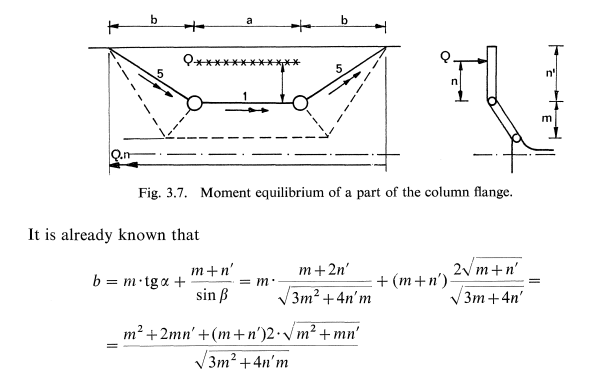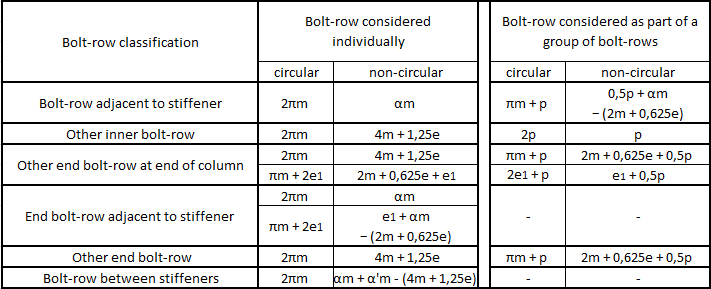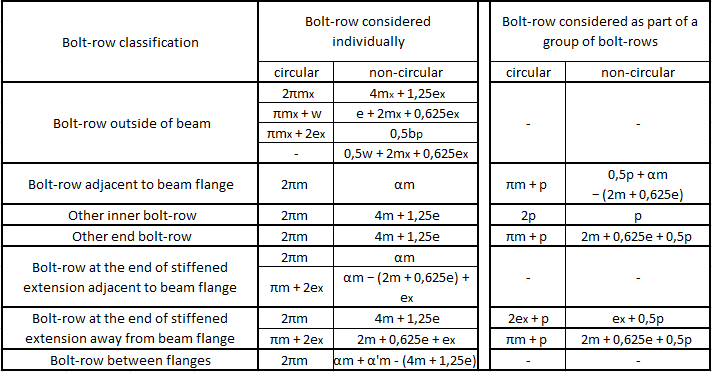Open topic with navigation

Classification of Bolt-rows
The EN 1993-1-8 Art. 6.2.6.4 Table 6.4 and 6.5 and Art. 6.2.6.5 Table 6.6 specifies, how the bolt-rows should be classified either for a column, respectively end-plate side. According to this classification effective lengths, both for individual and group approach, are calculated.
The classification for both sides has been extended based on publication Joints in Steel Construction - Moment -Resisting Joints to Eurocode 3 (P398) with relation to the possible yield lines and based on HERON vol. 20 publication by P. Zoetemeijer, with relation to the limit distance determining the border of influence of a stiffener or beam flange.

In general, if a space between bolt-row and a stiffener/beam flange is smaller than this "limit" value, the formulas taking into account the presence of obstacle (formulas including α coefficient) should be used. The real distance is measured not exactly to the obstacle, but to the part of the adjacent obstacle weld (similar approach as in calculation of m distance given by EN 1993-1-8 Art. 6.2.6.4 Figure 6.8).
The smaller value of 'n' from left or right side end-plate extensions is used in case of not symmetric end-plate.
Column side
Within SCIA Engineer, a bolt row may be classified on a column side as:
- Bolt-row adjacent to stiffener - if the bolt row lies next to a stiffener and is within limit distance
- Other inner bolt-row - if the bolt-row lies between other bolt-rows
- Other end bolt-row - if the bolt-row lies next to a stiffener, which is farther away to the axis of a connected beam, and is outside the limit distance
- End bolt-row adjacent to stiffener - if the bolt-row is the first or the last bolt-row, lies next to a stiffener, which is closer to the axis of a connected beam
- Other end bolt-row at end of column - if the bolt-row is the first or the last bolt-row, lies next to a stiffener, which is closer to the axis of a connected beam, and is outside the limit distance or if the bolt-row is the first or the last bolt-row and does not lie next to a stiffener
- Bolt-row between stiffeners - if the bolt row is the only bolt-row between stiffeners and lies within the limit distance of both stiffeners
Effective length formulas for column flange classifications :

End-plate side
Within SCIA Engineer, a bolt row may be classified on an end-plate side as:
- Bolt-row outside of beam - if the bolt-row lies outside of the connected beam on an ustiffened end-plate extension (no plate haunch is present)
- Bolt-row adjacent to beam flange - if the bolt-row lies next to a beam flange and is within limit distance
- Other inner bolt-row - if the bolt-row lies between other bolt-rows
- Other end bolt-row - if the bolt-row lies next to a beam flange, which is farther away to the axis of a connected beam, and is outside the limit distance or lies on a stiffened end-plate extension, lies next to a beam flange and is outside limit distance
- Bolt-row at the end of stiffened extension adjacent to beam flange - if the bolt-row is the first or the last bolt-row, lies on a stiffened end-plate extension, lies next to a beam flange and is within limit distance
- Bolt-row at the end of stiffened extension away from beam flange - if the bolt-row is the first or the last bolt-row, lies on a stiffened end-plate extension, lies next to a beam flange and is outside limit distance or if the bolt-row is the first or the last bolt-row, lies on a stiffened end-plate extension and does not lie next to a beam flange
- Bolt-row between flanges - if the bolt row is the only bolt-row between beam flanges and lies within the limit distance of both flanges
Effective length formulas for end-plate classifications :

For the calculation of group "start" and "end" partial effective lengths for bolt-rows classified as "Other inner bolt-row", the formulas for "Other end bolt-row" are being used. (See also chapter: "Group of bolt-rows")
Open topic with navigation




